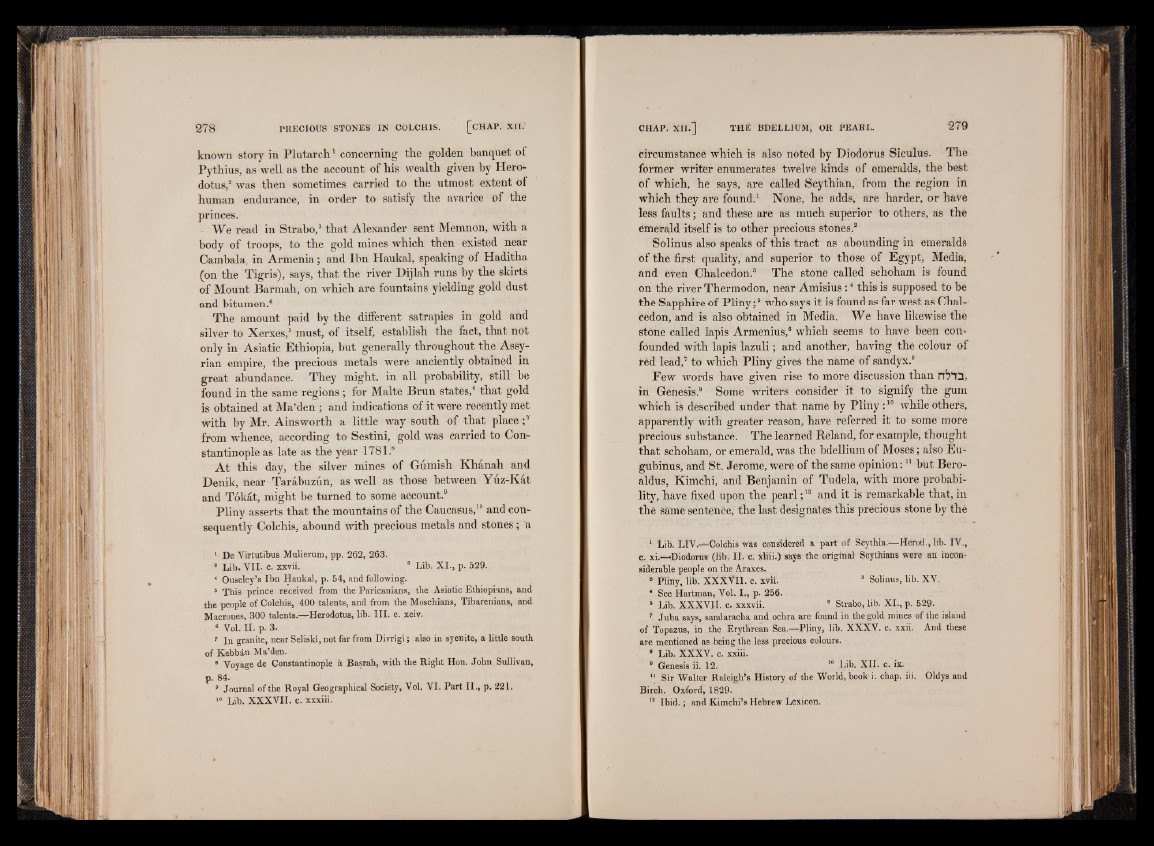
known story in Plutarch1 concerning the golden banquet of
Pythius, as well as the account of his wealth given by Herodotus,
2 was then sometimes carried to the utmost extent of
human endurance, in order to satisfy the avarice of the
princes.
- We read in Strabo,3 that Alexander sent Memnon, with a
body of troops, to the gold mines which then existed near
Cambala, in Armenia; and Ibn Haukal, speaking of Haditha
(on the Tigris), says, that the river Dijlah runs by the skirts
of Mount Barmah, on which are fountains yielding gold dust
and bitumen.4
The amount paid by the different satrapies in gold and
silver to Xerxes,5 must, of itself, establish the fact, that not
only in Asiatic Ethiopia, but generally throughout the Assyrian
empire, the precious metals were anciently obtained in
great abundance. They might, in all probability, still be
found in the same regions; for Malte Brun states,6 that gold
is obtained at Ma’den ; and indications of it were recently met
with by Mr. Ainsworth a little way south of that place;7
from whence, according to Sestini, gold was carried to Constantinople
as late as the year 1781.8
At this day, the silver mines of Gumish Khanah and
Denik, near Tarabuzun, as well as those between Yuz-Kat
and Tokat, might be turned to some account.9
Pliny asserts that the mountains of the Caucasus,10 and consequently
Colchis, abound with precious metals and stones; ‘a
1 De Virtutibus Mulierum, pp. 262, 263.
a Lib. VII. c. xxvii. 3 Lib. XI., p. 529.
4 Ouseley’s Ibn Haukal, p. 54, and following.
5 This prince received from the Paricanians, the Asiatic Ethiopians, and
the people of Colchis, 400 talents, and from the Moschians, Tibarenians, and
Macrones, 300 talents.—Herodotus, lib. III. c. xciv.
8 Vol. H. p. 3.
7 In granite, near Seliski, not far from Divrlgi; also in syenite, a little south
of Kebbin Ma’den.
8 Voyage de Constantinople a Basrah, with the Right Hon. John Sullivan,
p. 84.
8 Journal of the Royal Geographical Society, Vol. VI. Part II., p. 221.
18 Lib. XXXVII. c. xxxiii.
circumstance which is also noted by Diodorus Siculus. The
former writer enumerates twelve kinds of emeralds, the best
of which, he says, are called Scythian, from the region in
which they áre found.1 None, he adds, áre harder, or have
less faults ; and these are as much superior to others, as the
emeradd itself is to other precious stones.2
Solinus also speaks of this tract as abounding in emeralds
of the first quality, and superior to those of Egypt, Media,
and even Chalcedon.3 The stone called schoham is found
on the river Thermodon, near Amisius :4 this is Supposed to be
the Sapphire of Pliny ;5 who says it is found as far west as Chalcedon,
and is also obtained in Media. We have likewise the
stone called lapis Armenius,4 whieh seems to have been confounded
with lapis lazuli ; and another, having the colour of
red lead,7 to which Pliny gives the name of sandyx.8
Few words have given rise to more discussion than nb“D,
in Genesis.9 Some writers consider it to signify the gum
which is described under that name by Pliny :10 while others,
apparently with greater reason, have referred it to some more
precious substance. The learned Reland, for example, thought
that schoham, or emerald, was the bdellium of Moses ; also Eu-
gubinus, and St. Jerome, were of the same opinion : u but Bero-
aldus, Kimchi, and Benjamin of Tudela, with more probability,
have fixed upon the pearl ;12 and it is remarkable that, in
the same sentence, the last designates this precious stone by the
I Lib. LIV.—Colchis was considered a part df Scythia.—Héi*od.,lib. IV.,
g . xi.—Diodorus (lib. II. g. xliii.) says the original Scythians were an inconsiderable
people on the Araxes.
8 Pliny, lib. XXXVII. c. XWi. 3 Solinus, lib. XV.
4 See Hartman, Vol. I., p. 256.
5 Lib. XXXVII. c. xxxvii. 8 Strabo, lib. XI., p. 529.
7 Juba says, sandaracha and ochra are found in the gold mines of the island
of Topazus, in the Erythrean Sea.—Pliny, lib. XXXV. c. xxii. And these
are mentioned as-being the less precious colours.
8 Lib. XXXV. c. xxiii.
8 Genesis ii. 12. 10 Lib. XII. c. ix.
II Sir Walter Raleigh’s History of the World, book i. chap. iii. Oldys and
Birch. Oxford, 1829.
14 Ibid. ; and Kimchi’s Hebrew Lexicon.